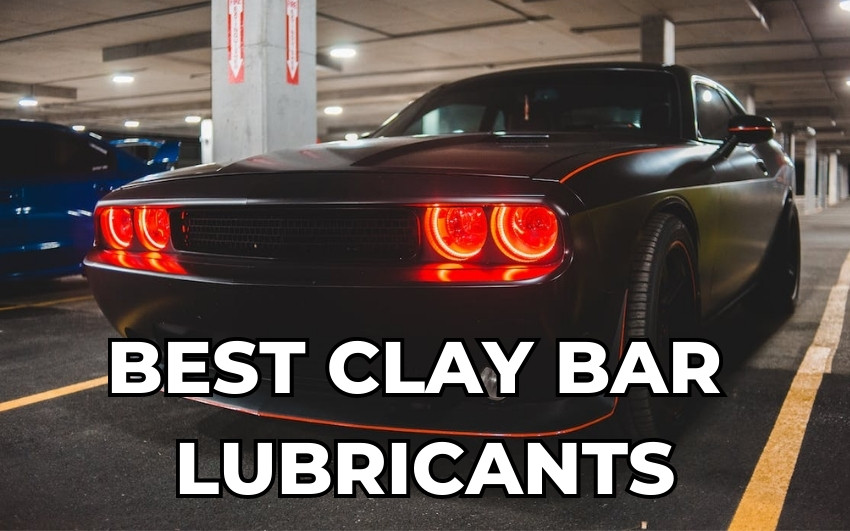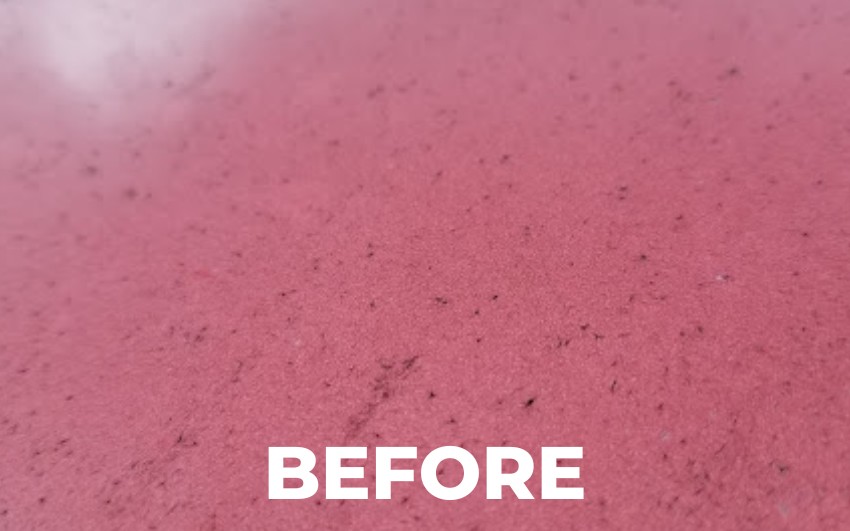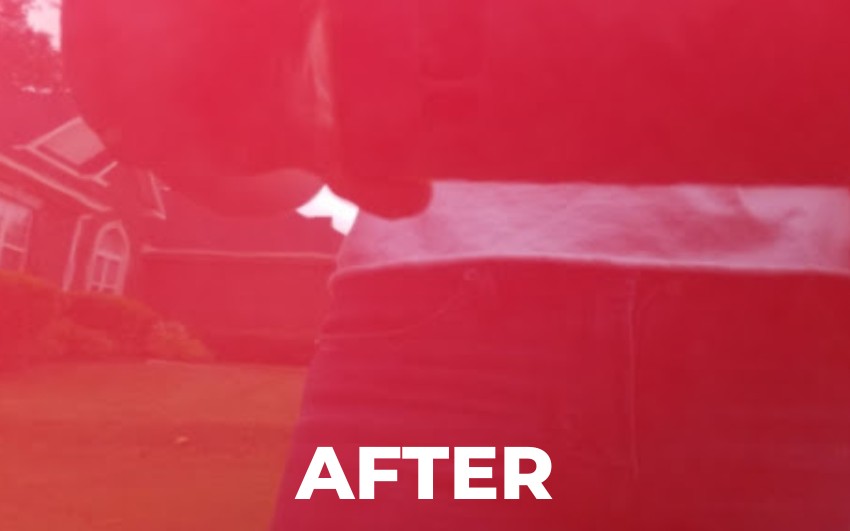
If you run the palm of your hand across the hood of your car and hear a dry, rough sound, that is the sound of millions of microscopic pores within your paintwork screaming at you for help. This isn’t the kind of mess you can just wash away. It’s time to bring out the clay bar and a quality lubricant.
Here we’re bringing you our recommendations on the best clay bar lubricants on the market.
Why Clay Bar Lubricants Are Important For Paint Decontamination
To put it as simply as possible, a clay bar can’t glide over your car’s panels without adding some type of lubrication. The silky fluid is what allows your clay bar to lay evenly on top of your paintwork, allowing you to swipe it across the panels of your car.
The easier your clay bar glides over the surface of your vehicle, the more pollutants like water spots, pollen, and road grime that it’s able to pull out of your clear coat.
Additionally, clay bar lubricants help loosen contaminants from the pores of your paintwork, helping to prolong the life of your car’s exterior appearance.
Rubbing a dry clay bar across the hood of your car would be like dragging a pencil eraser across your TV screen. You just wouldn’t do that to something you love. You’ll be left with marring all over what was freshly cleaned paintwork. Furthermore, we all know that water makes a terrible lubricant due to its dragging effects on clay. So what is the best-dedicated clay bar lubricant?
3 Best Dedicated Clay Bar Lubricants
There are so many options for clay bar lubricants that you might find yourself standing in the auto shop aisle wondering what the difference is. We’ve gone ahead and tried them all for you and rounded up the top three best clay bar lubricants.
Additionally, we’ve included a list of safe clay bar lubricant alternatives to get you by if you can’t get your hands on a dedicated lubricant.
1. Chemical Guys Clay Luber
Chemical Guys is pretty well known for their consistency in making affordable, quality detailing products, and their clay luber is no exception. On your initial pass, you might feel a little friction, but that lasts mere seconds. As soon as this lubricant has adhered to your clay bar, it will feel like you’re gliding across silk.
Another key feature of this particular luber is its versatility. In addition to your paintwork, Chemical Guys Clay Luber can be safely and effectively used on auto glass, clear plastics (like headlights), and vinyl and rubber exteriors. This multi-faceted feature puts it above the competition.
Pros:
- Incredibly slick
- Safe to use on paintwork, auto glass, clear plastics, vinyl, and rubber.
- Easily found in many brick-and-mortar stores
- Cheap
Cons:
- The blue dye will stain your skin
- Bottles break easily
2. Car Gods Clay Bar Lubricant
Car Gods Clay Bar Lubricant is another great choice because of how incredibly smooth it is. The chemical makeup helps lift the debris out of your pores along with the clay. You don’t have to use very much per section to achieve that desirable gliding effect.
While I find the slickness of this lubricant to be impressive, the issue I run into is not being able to clay over my headlights with this product. It’s certainly not a deal breaker due to how effective this product is over paintwork and glass.
Pros:
- It can also be used on auto glass and alloy wheels
- Leaves a smooth finish
Cons:
- Will cause a foggy effect if used on clear plastics, like headlights
- It can be difficult to find, but it is available on their website and on Amazon
3. Torque Clay Lube Spray
Torque is another well-known brand in the world of auto detailing. This lubricant does a great job of loosening any gunk hiding in your paintwork, taking a bit of the elbow grease out of the claying process. Another bonus is the vibrant green color.
While I typically view added colorants to be a waste and sometimes even a bit of a nuisance, the coloring makes it easy to see exactly where the spray is sitting as well as where your clay has already swiped over.
Pros:
- Helps bring contaminants to the surface
- Creates a slick surface to help your clay glide
- Vibrant color helps map out your progress
- Made in USA
Cons:
- A little more expensive than the other products on this list
- It can be difficult to find, but it is available on their website and on Amazon
Alternative Products You Can Use as Lubricants
Yesterday I went to my nearest auto shop to restock on a few basic detailing items. A clay bar lubricant is one of the items on my list. To my surprise, there were none on the shelf. Rather than drive out to other stores or start calling around, I figured it would be easier to use a clay bar lubricant alternative.
Detail Sprays (the best overall)
Quick detail sprays make the best lubricant alternatives. To be honest, I think they make the best clay lubricants, period. If you like to keep your ride fresh, chances are you already have a bottle of quick detail spray in your trunk or glove box.
Now if you’re wondering if the brand matters, I would say yes. My vote goes to Nexgen Quick Detailer. Not only does this stuff make cleanups a breeze, the chemical makeup actually feels silky. This is exactly what you would want between a clay bar and your paintwork.
Adding to the convenience of being able to use a quick detailer as a multi-purpose item, it also expands the number of surfaces you can safely clay over. Whatever brand you happen to have on hand, detail sprays as clay bar lubricants are your best bet if you’re ever without a dedicated clay bar lubricant or want to stick with versatile products.
Car Shampoos (mix of car shampoos with water)
If you’re in a hurry and want to get your car clayed with as few steps as possible, you might want to opt for your regular car shampoo. If you’re handwashing your vehicle, you could wash one panel at a time, clay it, then use a dry microfiber towel to wipe the panel dry quickly.
Waterless and Rinseless Products
An important similarity between a clay bar lubricant and a waterless wash is that instead of rinsing your car off, you use a microfiber cloth to wipe away the excess product. If you’re using a clay bar to remove water spots, you wouldn’t want to use then a lubricant alternative that requires you to add more water after the fact. While I personally don’t find the slickness of a waterless wash to be impressive, it will still create a soft enough surface to get you through the process.
Avoid Using These as Clay Bar Lubricants
Now if you’re looking around your house wondering what else you can use in place of a clay bar lubricant you should also know what not to use. Below is a short list of some products you should never use in place of a claying lubricant.
All-Purpose Cleaners
APCs make terrible lubricants and are terrible for your car’s exterior in general. They don’t provide enough lubrication, which will leave you with marring or swirls. Additionally, harsh chemicals can damage your paintwork.
IPA Solutions
It would take you mere seconds to regret using an IPA Solution with a clay bar. To start, you’d be rubbing a mix of alcohol and water over your paintwork. Both of which will cause your clay to jagger across your car’s panels. IPA solutions will ruin your clay bar and could damage your top coat if used incorrectly.
Spray Waxes
You may consider trying to combine steps here, and that would be a mistake. It’s important to clay your car, then wax. If attempted in a single step, you would be pulling and resealing contaminants, making no progress, and creating a build-up of wax within your clay.
Spray Ceramic Coatings
The purpose of a spray ceramic coating is to create a hard shell over the surface of the vehicle. Any contaminants on your panels would then be locked within the ceramic barrier. Additionally, just like the spray wax, you’d create a buildup of product within your clay, wasting a perfectly good bar.
Dish Soaps
Most dish soaps are abrasive and will strip away your car’s clear coat as well as eat away at your clay bar. Do your car a favor and leave the dish soap in the kitchen.
How To Use Clay Bar Lubricants

This is my car’s paint before I did clay bar treatment
If you’ve never used a clay bar, it’s actually a pretty simple process to tack onto your detailing routine and really only needs to be done about twice a year. The first step is to go through your regular hand-wash routine. Make sure your vehicle is clean and completely dry. With the surface clean, your clay will be able to better pull from the pores within your paintwork.
As with all detailing products, you’ll want to move your car out of direct sunlight before applying the lubricant. To prevent the product from self-drying, you’ll want to spray your lubricant on small sections of clay, then wipe away the excess fluid with a microfiber towel. If you feel that your clay is dragging a bit, you’ll need to spray a little more lubricant onto that section.
This is how I use a clay bar on my car:
- Thoroughly wash and dry your car.
- Move your vehicle out of direct sunlight
- Break off the desired amount of clay from the bar.
- Knead the clay between your fingers until it almost resembles a disc shape
- Spray your chosen lubricant on one section at a time.
- Immediately wipe your clay from side to side, then up to down until your panel feels smooth. Spray on more lubricant as needed.
- Use a clean, dry microfiber cloth to wipe away the now-dirty lubricant from your car.
- Continue working in sections over all desired surfaces.

Condition of my car’s paint after I’ve done clay bar treatment
Conclusion
The average vehicle should be clay barred about twice per year. With the right tools, claying can be quick and easy. Getting a high-end finish requires a great lubricant to help dissolve and pull out contaminants like metals, dirt, and pollen from deep within the pores of your paintwork. It will also remove films that build up over time on your windshield and other auto glass, which would be hazardous over time.
Sometimes the best clay bar lubricants weren’t made for claying. If you’re ever without a dedicated lubricant or just don’t care to buy an extra product, I highly recommend a good detailing spray as an alternative. A quick detailing spray will do an excellent job of pulling away particles from your car’s exterior and also create a fantastic slick surface to help your clay slide across each surface.






